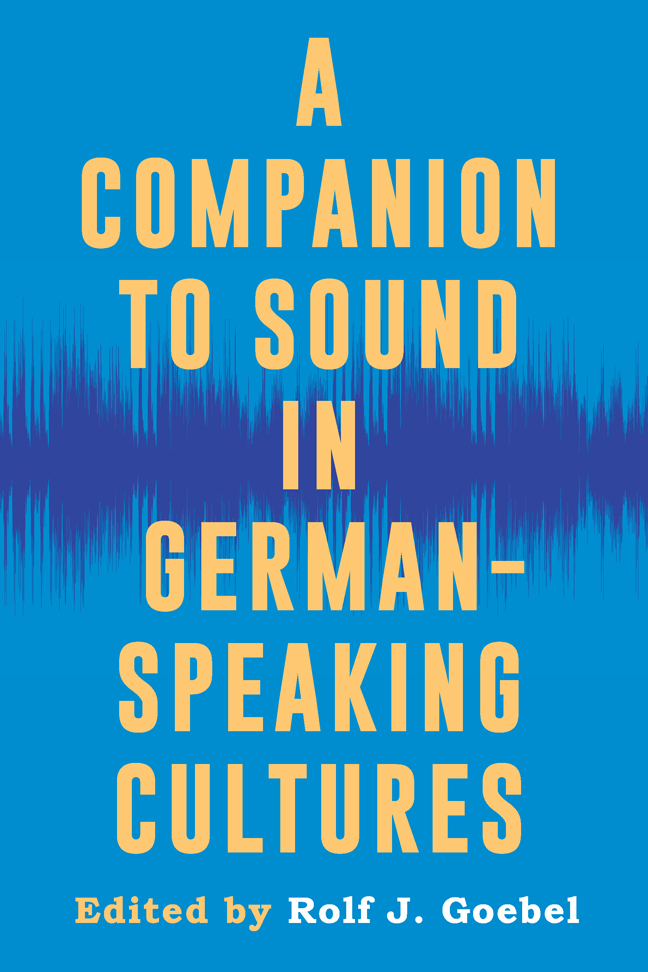Book contents
- Frontmatter
- Contents
- List of Illustrations
- Preface
- Introduction
- Part I Sonic Practices from the Middle Ages to the Nineteenth Century
- Part II Rediscovering the Sounds of Modernism
- Part III Listening to the Unbearable: The Sounds of National Socialism and the Holocaust
- Part IV After the Catastrophe: Sounds in Postwar Germany and Beyond
- Part V Sounds of the Present
- Part VI Epilogue
- Select Bibliography and Further Reading
- Notes on the Contributors
- Index
4 - Heidegger: A Little Hint on How to Listen
Published online by Cambridge University Press: 21 February 2024
- Frontmatter
- Contents
- List of Illustrations
- Preface
- Introduction
- Part I Sonic Practices from the Middle Ages to the Nineteenth Century
- Part II Rediscovering the Sounds of Modernism
- Part III Listening to the Unbearable: The Sounds of National Socialism and the Holocaust
- Part IV After the Catastrophe: Sounds in Postwar Germany and Beyond
- Part V Sounds of the Present
- Part VI Epilogue
- Select Bibliography and Further Reading
- Notes on the Contributors
- Index
Summary
I. Introduction
Martin Heidegger Remains a notorious thinker, notorious for his Nazism and for the alleged opacity of his writings and lectures. Yet it is difficult to think of many others who have exerted so much influence on the trajectories of twentieth-century thought. One particularly interesting element of his corpus is the way he frequently foregrounds listening. Others in the phenomenological tradition generally focused on the εἶδoς (eidos—the visual aspect of experience) or treated questions of listening in a way that subordinates the experience to what is being heard, especially in the context of music. Maurice Merleau-Ponty dedicated two small notes to music that he sadly never much expanded upon, and most of his other examples are either centered around bodily experience (that is, phantom limb syndrome) or seeing, as in the case of his famous reading of Cézanne. Roman Ingarden, the Polish student of Husserl, certainly wrote much on the subject of music, including perhaps one of the most sustained phenomenological engagements with questions of music's ontology, yet listening itself was left mostly fallow. Another student of Husserl (and later of Heidegger), Günther Anders, centered his early work around the phenomenology of music; a collection of this work was recently published. Edmund Husserl, Heidegger's major teacher, was overtly engaged with questions of music and sound, although references to these subjects remain spare throughout his work; at the beginning of perhaps the inaugural text of modern phenomenology, Ideas, he evokes the question of Ton (tone), which, in German, at least in a more explicit sense than in English, contains valences of both music and sound simultaneously (and therefore serves as an ideal piece of deconstructive vocabulary for those interested in critiquing the boundary between music and sound), and his analysis of inner time-consciousness is dependent on the metaphor of a melody.
Heidegger's corpus positively abounds with central terms that are clearly sonic in their frame of reference yet are only very rarely explicitly linked with music. A few examples: Stimmung (often translated as mood, but can also be used to refer to the tuning of an instrument), Gewissensruf (call of conscience), horchen (hearkening), and, of course, hören (listening) itself. Elsewhere, there are intriguing references to the Lied der Erde (Earth's song).
In this chapter, Heidegger's relationship to sonic phenomena will be explored in a broad and general fashion.
- Type
- Chapter
- Information
- A Companion to Sound in German-Speaking Cultures , pp. 69 - 81Publisher: Boydell & BrewerPrint publication year: 2023



